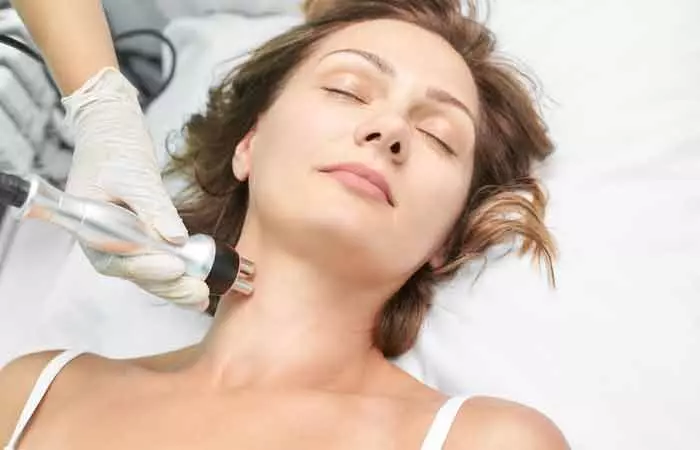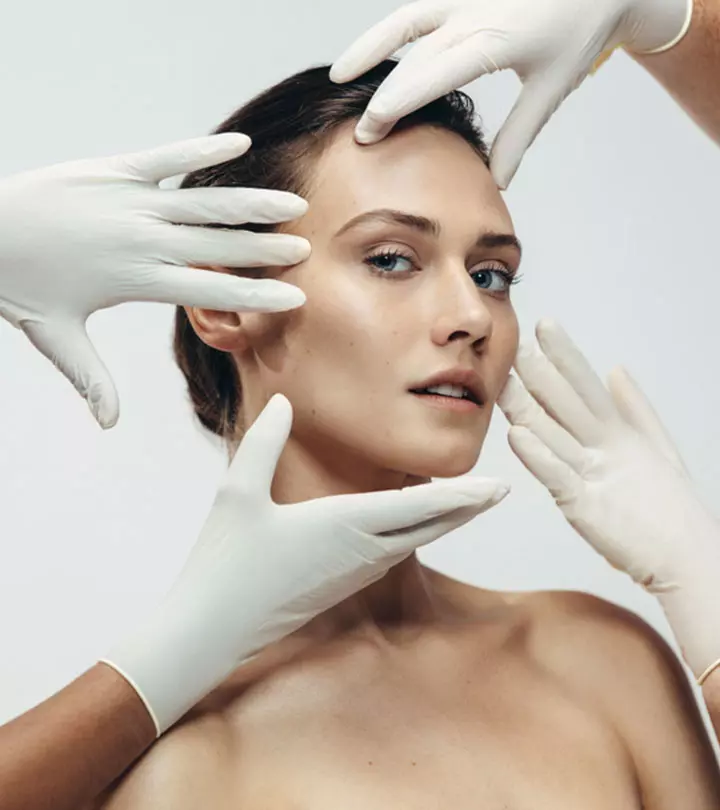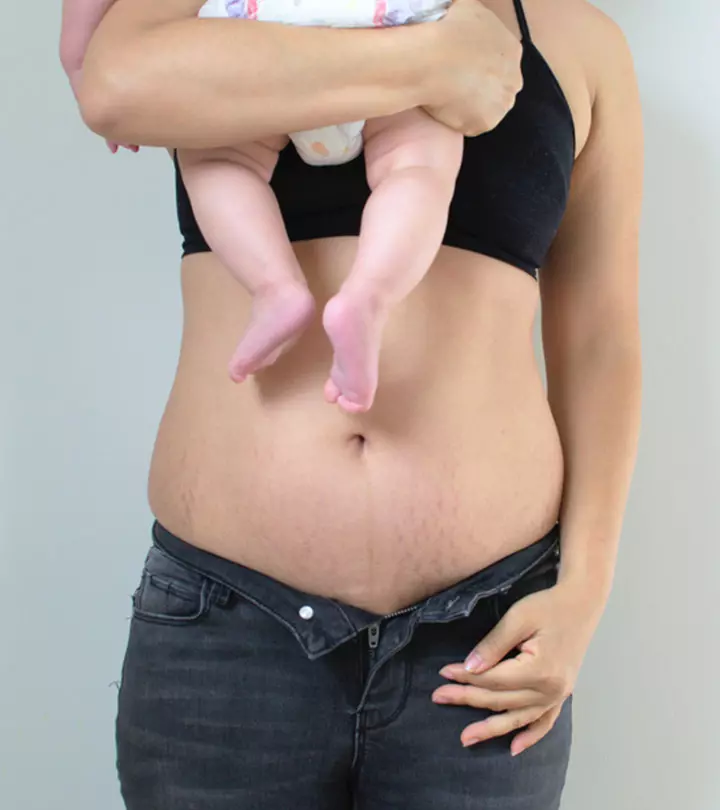Boxcar Scars: Causes, How To Recognize, And How To Treat Them
Identify your boxcar scars and explore ways to effectively minimize and treat them.

Image: Shutterstock
Boxcar scars are marks caused by severe acne or an infectious disease like chickenpox. They are the most common type of atrophic scars. They can be shallow or deep and appear pitted or indented. Scars develop due to collagen loss in that area. While you cannot get rid of them, they may fade over time. However, some treatments may help minimize their appearance to a great extent. Scroll down to learn more about boxcar scars and ways to treat them.
In This Article
Recognizing Boxcar Scars

Boxcar scars are one of the three main types (and most common) of atrophic scars. About 20% to 30% of all atrophic scars are boxcar scars.
Boxcar scars can be shallow or deep. The shallow scars have a diameter between 0.1-0.5 mm and are much easier to treat, and the deeper scars are around 0.5 mm or more and may be resistant to treatment. The scars may appear as round or oval depressions, with clearly demarcated vertical edges (1).
Atrophic scarring mainly occurs when your skin is healing itself from severe acne or blisters left behind by chickenpox. The type of scarring also depends on how the wound site or lesions are healing. Let’s understand in detail.
Key Takeaways
- Boxcar scars are the most common atrophic scars caused by severe acne or an infectious condition like chickenpox.
- They may appear on your face, notably on the cheeks and lower jaw, depending on how your skin heals.
- Though boxcar scars do not go away, chemical peels, dermabrasion, microneedling, radiofrequency, ablative lasers, non-ablative lasers, fillers, punch excision, punch elevation, and chemical reconstruction of skin scars can improve their appearance.
How Do Boxcar Scars Develop?
The skin has several layers, and the key components of skin healing – collagen and elastin – form in the dermis, the second layer. Boxcar scars form when a severe injury affects the skin’s deep layers, and it cannot produce enough collagen to cover the injury site, and the area develops irregularities.
You may develop boxcar scars if you:
- Have severe forms of acne, such as papules, pustules, and nodules.
- Squeeze, pop, and scratch the lesions.
- Do not treat acne lesions.
- Are recovering from chickenpox.
Based on how your skin heals, you may notice boxcar scars (or a mix of different scar types) on your face, particularly on the cheeks and the lower jaw. Shallow boxcar scars may fade away over time and are easier to treat. However, deeper scars may take time to heal.
Do Boxcar Scars Go Away? How To Treat Them
No. Boxcar scars do not go away. In fact, the older you get, the more pronounced they might look due to lesser collagen production. However, there are multiple ways to treat boxcar scars and improve their appearance. They include:
1. Chemical Peels

Peels are a generalized approach to treating atrophic scars. They involve using a chemical on the skin that destroys the outer layer, accelerating the exfoliation process, leading to tissue remodeling. This helps reduce the scar’s appearance over time.
It is an in-office procedure, and the strength depends on the scar depth and skin tolerance levels. Chemical peeling can leave your skin vulnerable to UV damage. So avoid sun exposure right after peeling and use sunblock and protective clothing to prevent chances of hyperpigmentation (2).
Best For: Shallow boxcar scars and post-inflammatory hyperpigmentation
 Quick Tip
Quick Tip2. Dermabrasion
Dermabrasion involves using a device to remove the top layer of the skin. This method allows the dermatologist to precisely define scar edges.
You may notice mild redness for a while after the procedure. However, it subsides after a few hours. Dermabrasion helps improve the skin texture and appearance of scars. However, you may have to undergo multiple sessions for better results.
Best For: Shallow boxcar scars
3. Microneedling

This method involves pricking the skin with tiny needles to induce collagen and elastin production. This is also known as collagen induction therapy regrowth and is performed under the doctor’s supervision, under topical anesthesia. The number of sessions depends on the severity of the scars and how your skin is healing (1).
Microneedling is often combined with platelet-rich plasma (PRP) to provide cosmetic improvements. PRP is a concentrate of platelet-rich protein derived from the patient’s blood. It is used in conjunction with the needling to improve the scars (1), (3).
Vanessa, a YouTuber, details her experience of healing hyperpigmentation and deep pitted acne scars. She said, “In 2020, before the pandemic started, I got my very first professional microneedling treatment and the indented scars improved so much (i).”
Best For: Moderate to deep boxcar scars
4. Radiofrequency

This therapy delivers current through the dermis to stimulate collagen production to soften the look of scars. Radiofrequency can be used as a monotherapy or with fractional lasers to smoothen the skin texture.
Radiofrequency requires the use of a numbing agent and has a longer downtime than microneedling. You can see 25%-75% improvement after 3-4 sessions, and results are optimal three months after the final session (1).
Best For: Moderate to deep boxcar scars
5. Ablative Lasers
These are the big guns for scar treatments and give significant results after just one session. They show significant improvement in atrophic scars at 6 months after the laser treatment and up to 75% improvement after 18 months. However, they have the longest downtime and greater chances of adverse effects like pigmentation issues and discomfort (3).
The dermatologist may put you on antibiotics before treating your boxcar scars with ablative lasers. There are different kinds of ablative lasers, and the most common are the CO2 laser and Erbium laser.
Best For: Moderate to deep boxcar scars
6. Non-Ablative Lasers
These are newer forms of laser treatments that reduce the downtime post-treatment compared to ablative lasers. They also reduce the risk of damaging the upper skin layer. This is because non-ablative lasers deliver photothermal energy to the inner layers to stimulate the fibroblasts (cells producing collagen and elastin). Non-ablative lasers are much tolerable and have a short recovery time. However, the results are not often clinically impressive.
Best For: Shallow to moderate boxcar scars
7. Fillers

Dermal fillers are injected into the skin layers to improve the appearance of the depressed scars. There are three types of fillers (1):
- Temporary Fillers: These are hyaluronic acid fillers and may last for a few months. You may need frequent sessions to maintain the skin’s appearance.
- Semi-Permanent Fillers: These are biostimulatory (stimulate fibrous tissue formation) and show significant improvement in boxcar scars. These fillers may last for up to 2 years.
- Permanent Fillers: They can last up to 10 years and even for a lifetime. But they may move from the initial targeted area over time. They also come with the risk of side effects and may often require complete removal. Silicone or synthetic fillers like polymethylmethacrylate (PMMA) fillers are used for correcting the appearance of scars as these are affordable and stable.
Best For:
Moderate to deep boxcar scars
8. Punch Excision
This method involves using a punch instrument to puncture the area of the scar. After that, the scar tissue or inner layer is removed, and the wound is stitched. This method is known to work well with laser resurfacing.
Best For: Deep boxcar scars
9. Punch Elevation
In this method, after puncturing the scar with the punch instrument, the tissue is elevated and stitched slightly above the surrounding area. This contracts the wound and improves the appearance of wide boxcar scars.
Best For: Broad boxcar scars
 Quick Tip
Quick Tip10. Chemical Reconstruction Of Skin Scars (CROSS)
This technique involves using a high-strength trichloroacetic acid (TCA) peel at the base of the scar. This degrades the epithelial cells in the skin and stimulates skin remodeling.
TCA can promote the healthy production of collagen to diminish scars. This method provides satisfactory results in about 3 to 6 sessions (1), (3).
Best For: Narrow boxcar scars
11. Subcision Treatment
Subcision treatment is a surgical procedure that helps treat boxcar scars and deep wrinkles. It involves using a hypodermic needle that punctures the skin’s surface exactly beneath the scar to break the fiber connected to the scar, release collagen, and diminish the appearance of the scars. It is an easy, inexpensive treatment suitable for various skin types and involves no major complications altogether (4).
12. Cryotherapy Treatment
Cryotherapy involves using a freezing cold substance to destroy scar tissues and flatten the raised skin. A dermatologist often uses nitrogen or argon gas to create this severe cold. Also, it triggers the body’s natural inflammatory response, which helps in healing and stimulates the formation of new cells, improving the overall appearance of the skin. Cryotherapy also stimulates the skin’s collagen production and effectively addresses wrinkles and fine lines on the skin (5).
If you’re wondering how to prevent scarring or keep a scar from worsening, starting with at-home treatments may help with minor scars.
Preventing boxcar scars starts with addressing the root cause, managing acne effectively, and caring for your skin. Read our next section to learn more.
Preventative Measures
Here are some simple steps to help keep scars at bay:
- Resist the urge to squeeze or scratch acne lesions. This can worsen inflammation and damage deeper skin layers, increasing the likelihood of scars.
- Use products that won’t clog your pores, look for non-comedogenic products. Exfoliants like salicylic or glycolic acid can also help keep your pores clear and reduce inflammation.
- Prolonged sun exposure can worsen scarring and slow the healing process. Use a broad-spectrum sunscreen with at least SPF 30 to protect your skin.
- Begin treatment as soon as you notice acne breakouts. Consult a dermatologist to manage severe forms of acne, such as nodules and cysts, before they lead to scarring.
However, for moderate to severe scarring, it’s crucial to consult a professional. They can provide personalized treatments tailored to your skin type and the depth of the scar, ensuring optimal results.
Boxcar scars form once the inflammatory acne has healed. The scar formation mostly depends on how the skin heals and the acne treatment. To prevent boxcar scars, you must focus on proper acne management and aftercare. Always consult a doctor for treating severe acne and follow the prescribed treatment religiously. This can prevent deep scars. However, if you are concerned about the appearance of the scars, you may opt for the procedures discussed in the article. Talk to a doctor to understand which treatment options might suit your skin.
Frequently Asked Questions
Does retinol help with boxcar scars?
Yes, retinol, in combination with glycolic acid, may treat post-inflammatory hyperpigmentation and improve the appearance of scars (6).
Does Accutane help with boxcar scars?
Yes, studies suggest that Accutane (isotretinoin) may help in managing boxcar scars (7)
Does niacinamide help with boxcar scars?
Yes, niacinamide has wound-healing and anti-inflammatory properties that may reduce swelling and improve the appearance of acne scars (8), (9).
Do vitamin C pills help boxcar scars?
Vitamin C has anti-inflammatory properties that may boost collagen production and manage severe acne (9). The pills may also treat boxcar scars, though more research is needed in this regard.
Does Mederma work on boxcar scars?
No, there is currently no evidence that suggests that Mederma may help in treating boxcar scars.
Does Tretinoin help with boxcar scars?
Yes, the application of Tretinoin may help in flattening and reducing acne scars (10).
Can massaging a boxcar scar make it worse?
Anecdotal evidence suggests that massaging a boxcar scar may weaken scar tissue and flatten your scar. But more research is needed in this regard.
The following video shares a dermatologist’s insights on scar removal methods using scar creams like tretinoin and tazarotene. Watch now to minimize your scars effectively in minimal time by making informed choices.
Personal Experience: Source
StyleCraze's articles are interwoven with authentic personal narratives that provide depth and resonance to our content. Below are the sources of the personal accounts referenced in this article.
(i) Healing Hyperpigmentation + Deep Pitted Acne Scars (this is what I’ve done)https://www.youtube.com/watch?v=lE47T7HFK2M
References
Articles on StyleCraze are backed by verified information from peer-reviewed and academic research papers, reputed organizations, research institutions, and medical associations to ensure accuracy and relevance. Read our editorial policy to learn more.
- Acne Scarring—Pathogenesis Evaluation and Treatment Options
https://www.ncbi.nlm.nih.gov/labs/pmc/articles/PMC5749614/ - A systematic review of treatments for acne scarring. Part 1: Non-energy-based techniques
https://journals.sagepub.com/doi/pdf/10.1177/2059513117695312 - Review on the treatment of scars
https://www.oaepublish.com/articles/2347-9264.2020.166 - Effective Treatments of Atrophic Acne Scars
https://www.ncbi.nlm.nih.gov/pmc/articles/PMC4445894 - Cryotherapy in Dermatology
https://www.ncbi.nlm.nih.gov/books/NBK482319/ - Retinoic acid and glycolic acid combination in the treatment of acne scars
https://www.ncbi.nlm.nih.gov/pmc/articles/PMC4375771/ - Acne Scarring Management: Systematic Review and Evaluation
of the Evidence
https://www.cbamedicine.com/wp-content/uploads/2020/08/Acne-Scar-Management.pdf - An Investigation of Efficacy of Topical Niacinamide for the Treatment of Mild and Moderate Acne Vulgaris
https://www.researchgate.net/publication/228503323_An_Investigation_of_Efficacy_of_Topical_Niacinamide_for_the_Treatment_of_Mild_and_Moderate_Acne_Vulgaris - COSMECEUTICALS FOR THE SKIN: AN OVERVIEW
https://innovareacademics.in/journal/ajpcr/Vol4Issue2/260.pdf - Flattening of atrophic acne scars by using tretinoin by iontophoresis
https://pubmed.ncbi.nlm.nih.gov/15075042/
Read full bio of Dr. Sruthi Alla
Read full bio of Ramona Sinha
Read full bio of Eshna Das
Read full bio of Swathi E



























Community Experiences
Join the conversation and become a part of our empowering community! Share your stories, experiences, and insights to connect with other beauty, lifestyle, and health enthusiasts.